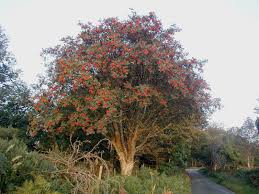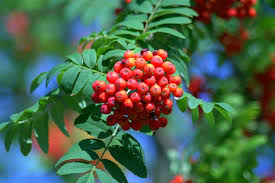|
Rowan Tree ( Sorbus aucuparia)
Delight of the eye is mountain ash, owing to the beauty of its berries. Delight of the eye. Strength or friend of cattle, the Elm. Strength of cattle. Book of Ballymote 1391 Rowan Fact File. Luis (Ogham name).Caorann (Gaelic). Rowan, like birch, was early in succession from the last ice age and is also most common in the highlands of Scotland; in fact the commonest tree except birch. Rowan is often confined to poor acid soils in Eastern England and is probably a naturalised species in southerly regions. Its berries are a food source for many birds connecting it to the musical spheres as well as a poetic muse for poets. The Sorbus family (see whitebeam blog) to which rowan belongs is an interesting collection of trees including the whitty pear (Sorbus domestica), Britain’s rarest tree. The more common whitebeam is a delightful tree growing more usually on limestone and chalk soils. The Wild Service-tree (Sorbus torminalis) has distinctive triangular lobed leaves and has a thin distribution across England as far north as the Lake District. The latter tree has been identified from charcoal from the late Iron Age and is often known as the Chequer Tree producing fruit which if left to go ‘sleepy’ (rather like medlars) can be used in home brewing. Rowan is steeped in ancient lore and medieval superstitions. Rowan may be a derivative of runa, a word meaning charm or spell and certainly has a strong connection with witches. Witches have used it to protect and work magic often with respect for it is said if they are touched by the tree the devil will consume them! The berries were said to induce altered states, and spells were said to be written on rowan staves. Older references also focus on its magical properties and it has a certain sinister reputation in the ancient legends, such as when meat is offered on rowan spits both to Finn MacColl by phantoms and to Cuchulainn, (famous Irish warrior), by the Morrigawn. There is an ancient magical ritual mentioned in old texts called ‘Tarbh Fheis’ which involves sleeping on a bed of woven rowan twigs to induce a magical trance in order to gain hidden knowledge. Rowan has been used for protection in the form of an equal-armed cross or by simply carrying the berries or wood with you at night especially at Midsummer to stop you being transported to the faerie realms. The tree can be planted instead of standing stones to guard earth energies. There is said to be a rowan guarded by the giant Searbhan Lochannoch called the Tree of Dubrois and it is said to transform a person of 100 years old to one 30 years old. Luis means ‘swarm’ or ‘great many’ which may refer to warriors and huntsmen who gather under the rowan as described in literature about the Tree of Clonfert and the Wry Rowan. The rowan has a strong connection with archetypal Goddesses especially Bridget and Brigantia both who preside over water cults, pastoral people, flocks and herds, connecting rowan to the green world and the lord of the hunt and cattle, which were key providers for the Celtic people. A female Druid, Dreco carried a magical rowan spear. Her grandfather was a Druid called Carton whose name is probably a corruption of the Gaelic word Caerthann which means rowan. Medicinally rowan’s bark is used for treating diarrhoea and its berries are used for sore throats. A delicious syrup can be made with rowan berries and crab apples. Learn more by subscribing to our monthly newsletter here.
0 Comments
Leave a Reply. |
Details
Poetry of flowersJoin me to explore the flora of the British Isles on this blog. My intention is to attempt to capture the unique quality and beauty of each species of flower, tree or shrub. For every species featured I will be growing many more wildflowers to celebrate the joy of their existence, their intrinsic conservation value and bewildering array of uses. For nearly 30 years I have noted, studied and explored wildflowers in the field much to the patience of the walker beside me. To share this passion is a heartfelt plea to respect, preserve and care for all British Wildflowers no matter how common they seem. Archives
February 2024
Categories |



 RSS Feed
RSS Feed
